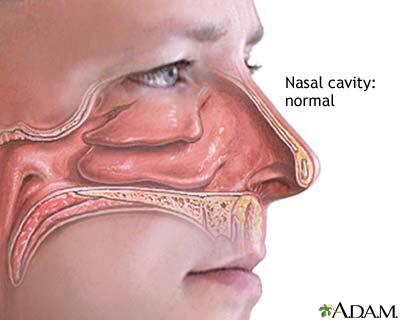| Allergic rhinitis |
Nasal allergies and asthma are similar conditions in different parts of the body.
- A majority of asthma patients have nasal symptoms.
- Many nasal allergy patients have asthma.
- Treating the allergic inflammation in the nose may help prevent asthma or reduce asthma severity and lower airway hyper-responsiveness.
Hay fever (allergic rhinitis) involves an allergic reaction to pollen. A virtually identical reaction occurs with allergy to mold, animal dander, dust, and similar inhaled allergens. The pollens that cause hay fever vary from person to person and from region to region. Pollens that are carried by bees from plant to plant are seldom responsible for hay fever because the grains are large and have a waxy coating. Tiny, hard-to-see pollens carried by the wind are more often the cause of hay fever.

NormalAllergic rhinitis
Examples of plants commonly responsible for hay fever include:
- Trees (deciduous and evergreen)
- Grasses
- Most flowers
- Ragweed
In addition to individual sensitivity and geographic differences in local plant populations, the amount of pollen in the air can be a factor in whether hay fever symptoms develop. Hot, dry, windy days are more likely to have increased amounts of pollen in the air than cool, damp, rainy days where pollen is washed to the ground.
When an allergen such as pollen or dust is inhaled by a person with a sensitized immune system, it triggers antibody production; these antibodies bind to cells that contain histamine. Histamine and other chemicals are released by these cells when the antibodies are stimulated by allergens. This causes itching, swelling of affected tissues, mucus production, muscle spasms, hives, rashes, and other symptoms. Symptoms vary in severity from person to person.
Symptoms
- Coughing
- Headache
- Itching of the nose, mouth, eyes, throat, skin, or any area
- Runny nose (rhinitis)
- Smell - impaired
- Sneezing
- Sore throat
- Stuffy nose (nasal congestion)
- Watery eyes
- Wheezing
History is important in diagnosing hay fever, including whether the symptoms vary according to time of day, the season, exposure to pets, diet changes, or other sources of potential allergens.
Skin testing is the most common method of allergy testing. This may include intradermal, scratch, patch, or other tests. Occasionally, the suspected allergen is dissolved and dropped onto the lower eyelid (conjunctiva) of the eye as a means of testing for allergies.
Some blood tests can be used to diagnose hay fever, but skin testing is more common.
Treatment
The best "treatment" is to avoid what causes your allergies in the first place. It may be impossible to completely avoid everything you are allergic to, but you can often take steps to reduce your exposure.
Medication options include the following:
- Antihistamines. many antihistamines are available. They include short-acting and long-acting forms. They come in tablets, nasal inhalers, eye drops, and syrups. Antihistamines are generally called first- or second-generation. First-generation antihistamines include diphenhydramine (Benadryl), clemastine (Tavist), and chlorpheniramine (Chlor-Trimeton) and brompheniramine (Dimetane). They may cause more side effects than newer second generation medicines. Second-generation antihistamines cause less drowsiness and can be equally effective, and usually do not interfere with learning. These medications include fexofenadine (Allegra), cetirizine (Zyrtec), levocetirizine (Xyzal), acrivastine (Semprex), loratadine (Claritin) and desloratidine (Clarinex). Some of these medicines are available wtihout a prescription.
- For people with symptoms not relieved by antihistamines alone, nasal corticosteroid sprays are very effective and safe. These prescription medications include fluticasone (Flonase), mometasone (Nasonex), and triamcinolone (Nasacort AQ).
- Decongestants may also be helpful in reducing symptoms such as nasal congestion, but should not be used for long periods.
- Cromolyn sodium is available as a nasal spray (Nasalcrom) for treating hay fever. Eye drop versions of cromolyn sodium and antihistamines are available for itchy, bloodshot eyes.
Allergy shots (immunotherapy) are occasionally recommended if the allergen cannot be avoided and symptoms are hard to control. It includes regular injections of the allergen, given in increasing doses (each dose is slightly larger than the previous dose) that may help the body adjust to the antigen.
Symptoms may sometimes be prevented by avoiding known allergens. Most trees produce pollen in the spring, grasses and flowers usually produce pollen during the summer, and ragweed and other late-blooming plants produce pollen during late summer and early autumn. During the pollen-producing times (pollen season), people with hay fever should remain indoors in an air conditioned-atmosphere whenever possible. For people that are sensitive to certain indoor allergens, dust mite covers for mattresses and pillowcases are recommended, as well as avoidance of culprit pets or other triggers.
References
Bahls C. In the clinic. Allergic rhinitis. Ann Intern Med. Apr 3, 2007;146(7):ITC4-1-ITC4-16.
Reviewed By: Allen J. Blaivas, DO, Clinical Assistant Professor of Medicine UMDNJ-NJMS, Attending Physician in the Division of Pulmonary, Critical Care, and Sleep Medicine, Department of Veteran Affairs, VA New Jersey Health Care System, East Orange, NJ. Review provided by VeriMed Healthcare Network. Previoulsy reviewed by David A. Kaufman, MD, Section Chief, Pulmonary, Critical Care & Sleep Medicine, Bridgeport Hospital-Yale New Haven Health System, and Assistant Clinical Professor, Yale University School of Medicine, New Haven, CT. Review provided by VeriMed Healthcare Network. (6/1/2010)
